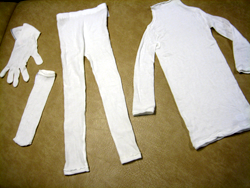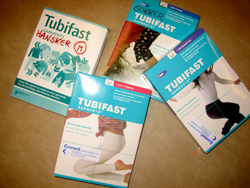NB:These are used for treatment of dry, itchy skin. Nowadays, it is more common to use ready-made wet garments instead of wet bandage. This page describes both modalities.
:. Wet garments
Clothes made of viscose may be used to moisturize dry and itchy eczematous skin. This serves as a supplement to other kinds of treatment, namely baths, steroids and emollients.
The garments have a cooling, softening and soothing effect. This is especially useful for alleviating itchiness at night. Wet garments are available in different forms, including shirts, tights, socks and gloves. Most come in all sizes up to 14 years old except the socks which only has one size and the gloves which have sizes available from 2 years old to adult.
New garments are washed at 60 degrees in the washing machine and are hung dry. Apply plenty of moisturizer on the skin areas that will be treated. It is recommended that an emollient with the maximum 30% lipid composition is used, but sometimes a higher lipid content may be applied. In terms of the degree of tolerance in an individual, it is based on trial and error.
Firstly, soak the garment with warm tap water. Wring out the excess water. Alternatively, one can put on a dry garment and moisten it using a water-filled squirt bottle subsequently. This should be done in a warm environment.
Secondly, a layer of dry clothes outside (e.g. Cotton pajamas) is needed. As the inner wet garments will quickly cool the body temperature, children should therefore lie in bed right after. For infants, one may alternate treatments between upper and lower body every other night to reduce body cooling. Alternatively, dry garments can be used but the moisturizing effect is not as good. If the fabric is stuck in ulcerated skin (especially in the morning), it can be loosened with a shower or a tub bath.


:. Wet wraps
Besides wet garments, wet gauze bandaging is a cheaper alternative. The wet bandage comes in different lengths and widths. It can be used to cover either the whole body or parts of the body.
Wet wrapping is an adjunctive therapy to other treatments such as baths, steroids and emollients. Wet wraps have a cooling and softening effect on the skin. Experience has shown that the soothing effect is more effective for alleviating night itching.
- Moisten the bandage with with warm water and place it on the skin that has been pre-treated with cream, followed by covering with dry tubegauze.
- Wet bandage should not be used on open / exuding wounds for fear of the bandage getting stuck in the wound.
- Apply plenty of moisturizer when one uses the wet bandage but not cream with high fat content – maximum 30%. This is because the thickness of the cream may render the bandage too “tight”, leading to formation of “bumps” and pustules on the skin
- You may try a variety of different emollients. Enquire about the lipid content at the pharmacy.
- There are also ready-made garments – Tubifast Garments – in various sizes. These are used in the same way as the bandages, ie a wet innermost layer and dry outside.
Applying the wet bandage
The room must be kept warm when wet wrapping is performed.
- Moisten half the length of the Tubifast gauze in body temperature water, wring excess water. Pull the damp part of the gauze on the itchy skin areas (e.g. arms, legs, body). Pull the dry part over. Make sure to place the dry layer about 3 cm over the edge of the wet layer to avoid pressure at the edges.
- To bind the different Tubifast parts together as a suit, cut two small holes in each part and ty together using a band. It is most reasonable to buy a soft textile band or strap and cut into desired lengths.
- Cut holes for the thumb, possibly all fingers through both layers. Make sure the holes are large enough. Arm lengths can be created with “mitten” and foot length with the “sock”. The child should wear pajamas outside the tubegauze not to be cold while sleeping. After a few hours check the humidity at the innermost gauze by pulling down the outer layer. Should the bandage feel too dry moisten it with a squirt bottle.
- Take the wet bandage off in the morning. If it is dry and stuck to the skin spray it with luke warm water before it is taken off.
- The method can also be used for the head / face. Here the gauze may be tied in a knot on top of the head. Cut holes for eyes / mouth and nose if necessary. Head / face bandage should be used only a few hours per day as the effect can be seen sooner. Never use head / face bandages for young children while they sleep.
Once a set of Tubifast has been adapted to the correct size, further sets may be prepared immediately, so that one always has a clean set available.
Wet bandages can be used many times and can be washable in 60 degrees water. The gauze shall not be reused (without being washed first) when it has been used with steroid creams. Also discard it after use on infected skin.
